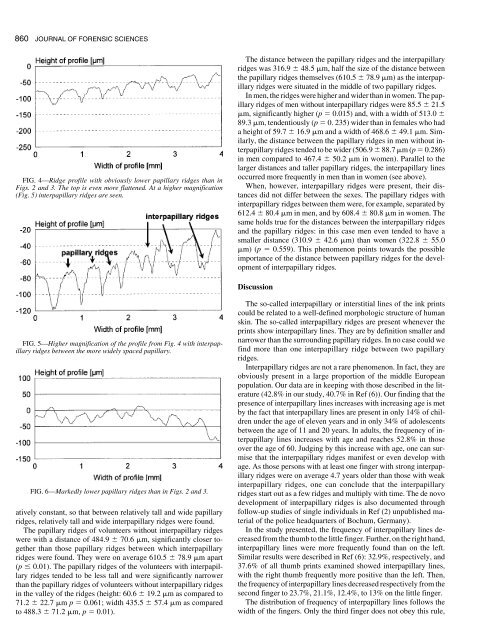Interpapillary lines--the variable part of the human fingerprint - Library
Interpapillary lines--the variable part of the human fingerprint - Library
Interpapillary lines--the variable part of the human fingerprint - Library
Create successful ePaper yourself
Turn your PDF publications into a flip-book with our unique Google optimized e-Paper software.
860 JOURNAL OF FORENSIC SCIENCES<br />
FIG. 4—Ridge pr<strong>of</strong>ile with obviously lower papillary ridges than in<br />
Figs. 2 and 3. The top is even more flattened. At a higher magnification<br />
(Fig. 5) interpapillary ridges are seen.<br />
FIG. 5—Higher magnification <strong>of</strong> <strong>the</strong> pr<strong>of</strong>ile from Fig. 4 with interpapillary<br />
ridges between <strong>the</strong> more widely spaced papillary.<br />
FIG. 6—Markedly lower papillary ridges than in Figs. 2 and 3.<br />
atively constant, so that between relatively tall and wide papillary<br />
ridges, relatively tall and wide interpapillary ridges were found.<br />
The papillary ridges <strong>of</strong> volunteers without interpapillary ridges<br />
were with a distance <strong>of</strong> 484.9 � 70.6 �m, significantly closer toge<strong>the</strong>r<br />
than those papillary ridges between which interpapillary<br />
ridges were found. They were on average 610.5 � 78.9 �m a<strong>part</strong><br />
(p � 0.01). The papillary ridges <strong>of</strong> <strong>the</strong> volunteers with interpapillary<br />
ridges tended to be less tall and were significantly narrower<br />
than <strong>the</strong> papillary ridges <strong>of</strong> volunteers without interpapillary ridges<br />
in <strong>the</strong> valley <strong>of</strong> <strong>the</strong> ridges (height: 60.6 � 19.2 �m as compared to<br />
71.2 � 22.7 �m p � 0.061; width 435.5 � 57.4 �m as compared<br />
to 488.3 � 71.2 �m, p � 0.01).<br />
The distance between <strong>the</strong> papillary ridges and <strong>the</strong> interpapillary<br />
ridges was 316.9 � 48.5 �m, half <strong>the</strong> size <strong>of</strong> <strong>the</strong> distance between<br />
<strong>the</strong> papillary ridges <strong>the</strong>mselves (610.5 � 78.9 �m) as <strong>the</strong> interpapillary<br />
ridges were situated in <strong>the</strong> middle <strong>of</strong> two papillary ridges.<br />
In men, <strong>the</strong> ridges were higher and wider than in women. The papillary<br />
ridges <strong>of</strong> men without interpapillary ridges were 85.5 � 21.5<br />
�m, significantly higher (p � 0.015) and, with a width <strong>of</strong> 513.0 �<br />
89.3 �m, tendentiously (p � 0. 235) wider than in females who had<br />
a height <strong>of</strong> 59.7 � 16.9 �m and a width <strong>of</strong> 468.6 � 49.1 �m. Similarly,<br />
<strong>the</strong> distance between <strong>the</strong> papillary ridges in men without interpapillary<br />
ridges tended to be wider (506.9 � 88.7 �m (p � 0.286)<br />
in men compared to 467.4 � 50.2 �m in women). Parallel to <strong>the</strong><br />
larger distances and taller papillary ridges, <strong>the</strong> interpapillary <strong>lines</strong><br />
occurred more frequently in men than in women (see above).<br />
When, however, interpapillary ridges were present, <strong>the</strong>ir distances<br />
did not differ between <strong>the</strong> sexes. The papillary ridges with<br />
interpapillary ridges between <strong>the</strong>m were, for example, separated by<br />
612.4 � 80.4 �m in men, and by 608.4 � 80.8 �m in women. The<br />
same holds true for <strong>the</strong> distances between <strong>the</strong> interpapillary ridges<br />
and <strong>the</strong> papillary ridges: in this case men even tended to have a<br />
smaller distance (310.9 � 42.6 �m) than women (322.8 � 55.0<br />
�m) (p � 0.559). This phenomenon points towards <strong>the</strong> possible<br />
importance <strong>of</strong> <strong>the</strong> distance between papillary ridges for <strong>the</strong> development<br />
<strong>of</strong> interpapillary ridges.<br />
Discussion<br />
The so-called interpapillary or interstitial <strong>lines</strong> <strong>of</strong> <strong>the</strong> ink prints<br />
could be related to a well-defined morphologic structure <strong>of</strong> <strong>human</strong><br />
skin. The so-called interpapillary ridges are present whenever <strong>the</strong><br />
prints show interpapillary <strong>lines</strong>. They are by definition smaller and<br />
narrower than <strong>the</strong> surrounding papillary ridges. In no case could we<br />
find more than one interpapillary ridge between two papillary<br />
ridges.<br />
<strong>Interpapillary</strong> ridges are not a rare phenomenon. In fact, <strong>the</strong>y are<br />
obviously present in a large proportion <strong>of</strong> <strong>the</strong> middle European<br />
population. Our data are in keeping with those described in <strong>the</strong> literature<br />
(42.8% in our study, 40.7% in Ref (6)). Our finding that <strong>the</strong><br />
presence <strong>of</strong> interpapillary <strong>lines</strong> increases with increasing age is met<br />
by <strong>the</strong> fact that interpapillary <strong>lines</strong> are present in only 14% <strong>of</strong> children<br />
under <strong>the</strong> age <strong>of</strong> eleven years and in only 34% <strong>of</strong> adolescents<br />
between <strong>the</strong> age <strong>of</strong> 11 and 20 years. In adults, <strong>the</strong> frequency <strong>of</strong> interpapillary<br />
<strong>lines</strong> increases with age and reaches 52.8% in those<br />
over <strong>the</strong> age <strong>of</strong> 60. Judging by this increase with age, one can surmise<br />
that <strong>the</strong> interpapillary ridges manifest or even develop with<br />
age. As those persons with at least one finger with strong interpapillary<br />
ridges were on average 4.7 years older than those with weak<br />
interpapillary ridges, one can conclude that <strong>the</strong> interpapillary<br />
ridges start out as a few ridges and multiply with time. The de novo<br />
development <strong>of</strong> interpapillary ridges is also documented through<br />
follow-up studies <strong>of</strong> single individuals in Ref (2) unpublished material<br />
<strong>of</strong> <strong>the</strong> police headquarters <strong>of</strong> Bochum, Germany).<br />
In <strong>the</strong> study presented, <strong>the</strong> frequency <strong>of</strong> interpapillary <strong>lines</strong> decreased<br />
from <strong>the</strong> thumb to <strong>the</strong> little finger. Fur<strong>the</strong>r, on <strong>the</strong> right hand,<br />
interpapillary <strong>lines</strong> were more frequently found than on <strong>the</strong> left.<br />
Similar results were described in Ref (6): 32.9%, respectively, and<br />
37.6% <strong>of</strong> all thumb prints examined showed interpapillary <strong>lines</strong>,<br />
with <strong>the</strong> right thumb frequently more positive than <strong>the</strong> left. Then,<br />
<strong>the</strong> frequency <strong>of</strong> interpapillary <strong>lines</strong> decreased respectively from <strong>the</strong><br />
second finger to 23.7%, 21.1%, 12.4%, to 13% on <strong>the</strong> little finger.<br />
The distribution <strong>of</strong> frequency <strong>of</strong> interpapillary <strong>lines</strong> follows <strong>the</strong><br />
width <strong>of</strong> <strong>the</strong> fingers. Only <strong>the</strong> third finger does not obey this rule,

















